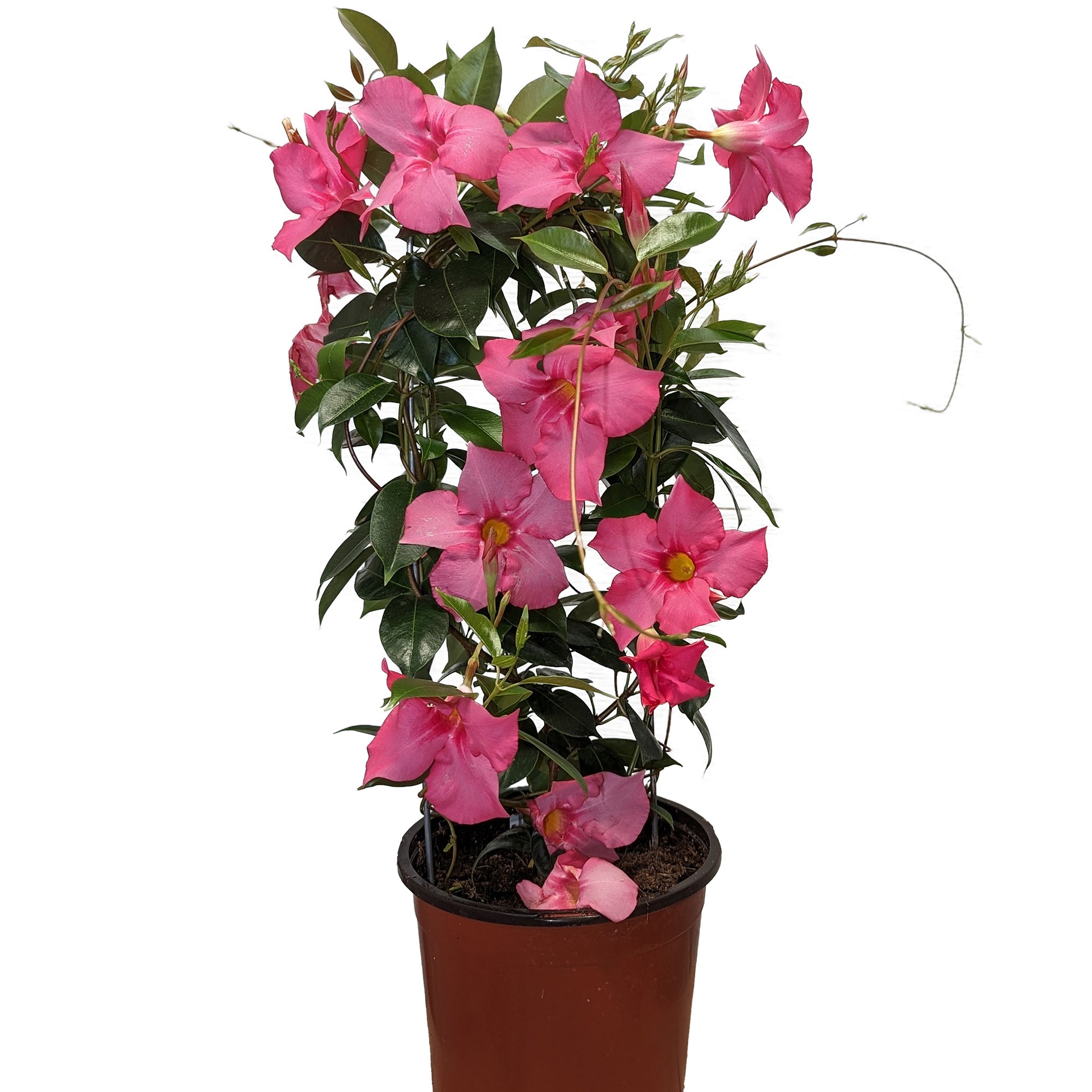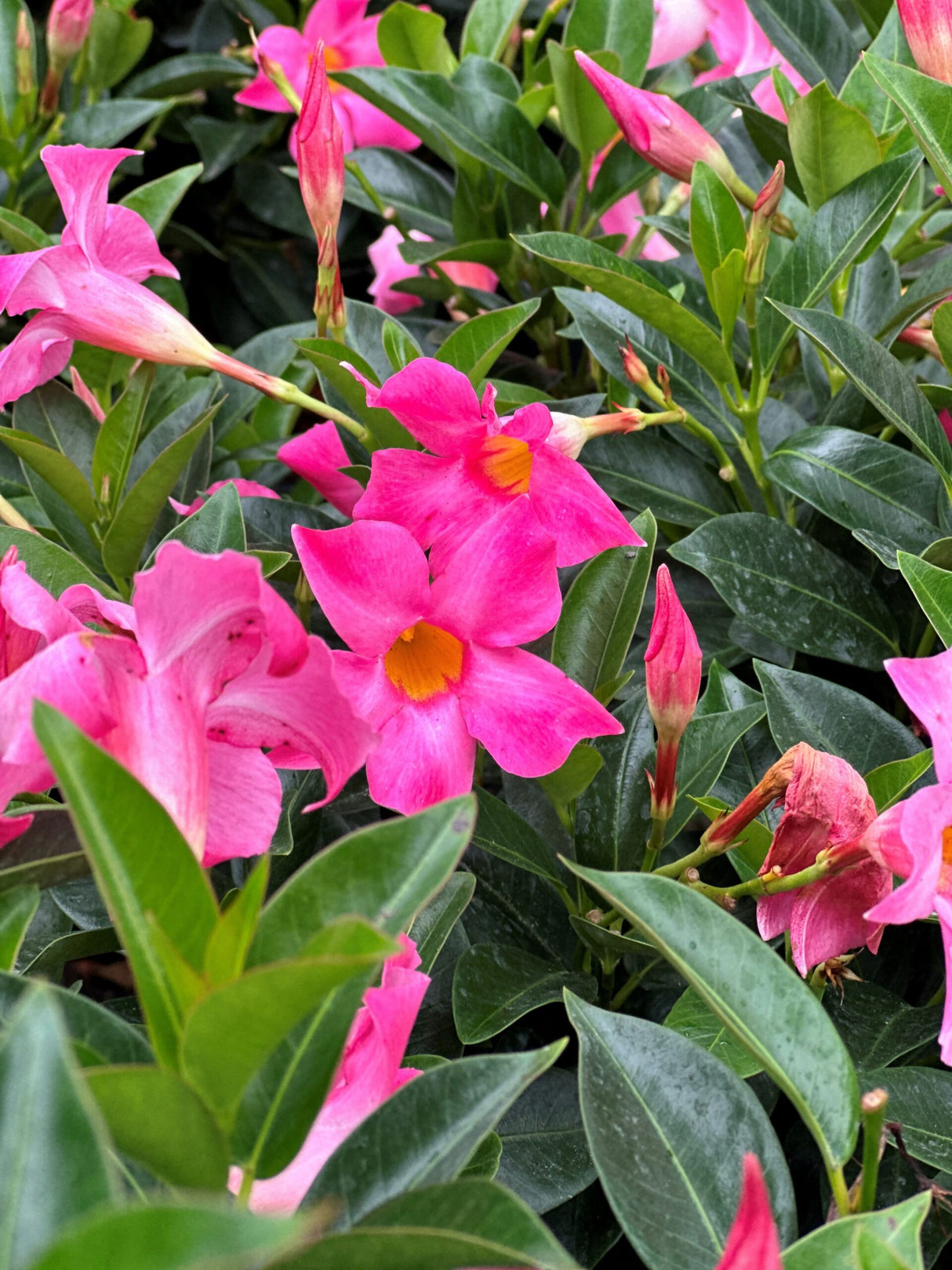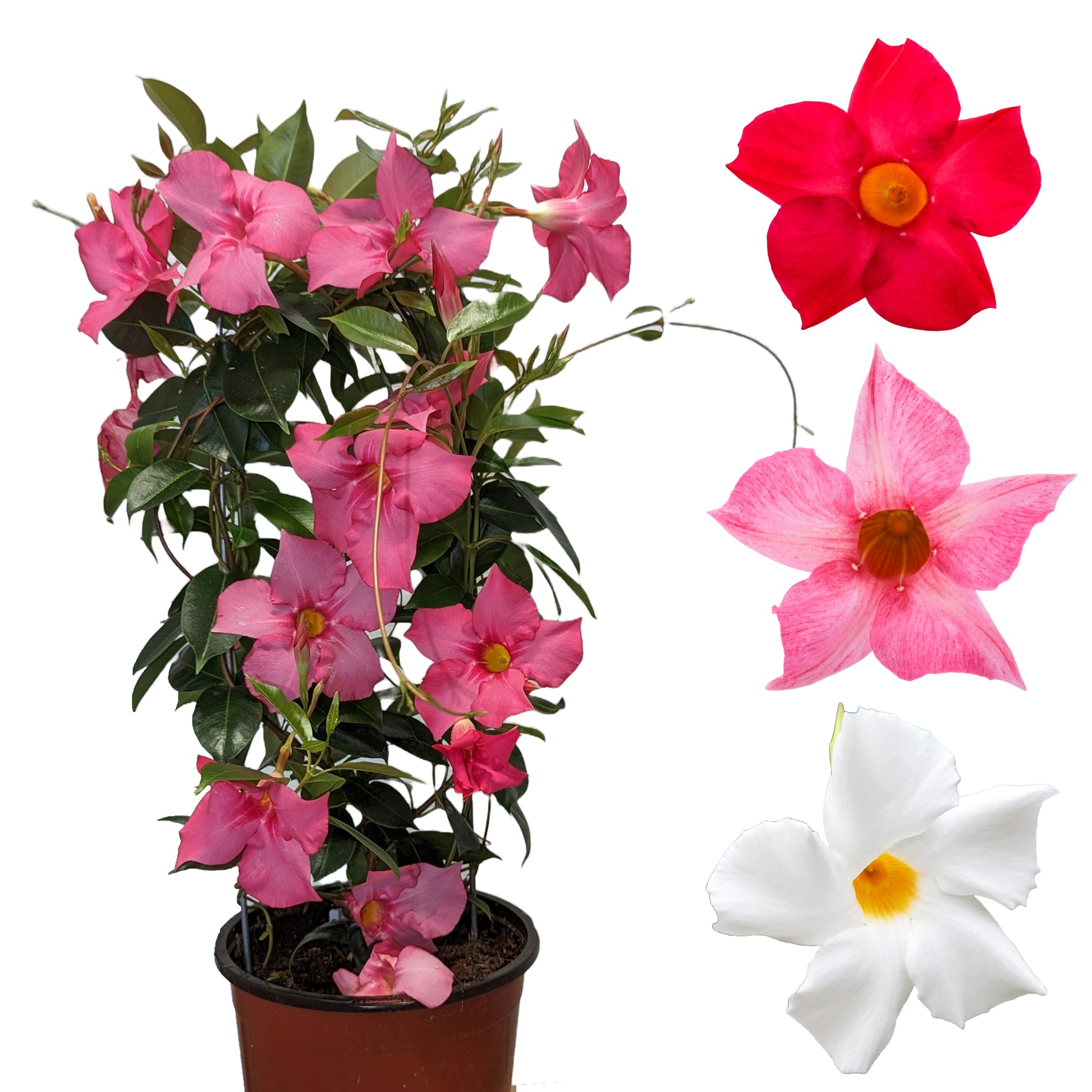Sure, here is an article about Dipladenia.
Dipladenia: Your Guide to a Beautiful, Easy-Care Tropical Vine
Looking to add a splash of vibrant color to your garden or patio without a lot of fuss? Then let’s talk about Dipladenia! Often confused with its close cousin Mandevilla, Dipladenia is a fantastic choice for both seasoned gardeners and those just starting out. It’s known for its stunning, trumpet-shaped flowers and its relatively easy-going nature, making it a real crowd-pleaser.

What Exactly Is a Dipladenia?
Imagine a plant that just loves to show off with an abundance of blooms in shades of red, pink, and white. That’s Dipladenia! These beauties are tropical plants, meaning they absolutely adore warmth and sunshine. While they look incredibly exotic, they’re surprisingly adaptable, especially when grown in containers. They tend to be a bit more compact and shrub-like than Mandevilla, making them perfect for smaller spaces or hanging baskets. Their leaves are typically a glossy dark green, providing a lovely backdrop for those spectacular flowers.
Why Is Dipladenia So Popular?
There are a few key reasons why Dipladenia has become a garden favorite. First and foremost, the flowers! They bloom profusely, often from spring all the way through to the first frost, giving you months of continuous color. Secondly, they’re relatively low-maintenance. They don’t demand constant attention, which is a huge plus for busy folks. Thirdly, their versatility is a big draw. You can grow them in pots, hanging baskets, or even as part of a mixed container arrangement. They look fantastic scrambling up a small trellis or just spilling over the sides of a planter.

Dipladenia vs. Mandevilla: What’s the Difference?
This is a common question, and honestly, even experienced gardeners sometimes get them mixed up! While they are both members of the Apocynaceae family (the dogbane family), there are some subtle differences.
# Growth Habit
Generally speaking, Mandevilla tends to be a more vigorous climber with longer, twining vines. Dipladenia, on the other hand, is usually more shrubby and compact. While it will trail or climb a bit, it’s not as aggressive as many Mandevillas. This makes Dipladenia a better choice for smaller trellises or when you want a fuller, bushier look in a pot.

# Leaves
If you look closely at the leaves, you’ll often notice a difference. Mandevilla leaves tend to be larger, often a bit duller, and sometimes have a slightly leathery feel. Dipladenia leaves are typically smaller, darker green, and have a beautiful glossy sheen.
# Flowers
Both produce beautiful trumpet-shaped flowers. However, Mandevilla flowers often have a more open, flared appearance, and can sometimes be larger. Dipladenia flowers tend to be a bit more tightly furled at the base, giving them a slightly more delicate look. That said, both offer a fantastic array of colors.
For most casual gardeners, the distinction isn’t critical. Both are beautiful, tropical bloomers. Just know that if you buy a “Mandevilla” that seems more compact and shrubby, it might actually be a Dipladenia, and vice-versa! Either way, you’re getting a gorgeous plant.
Getting Started: Planting Your Dipladenia
So, you’ve decided to bring a Dipladenia home. Excellent choice! Let’s talk about how to get it off to the best start.
# Choosing the Right Spot
Dipladenia thrives in bright light. Aim for a spot where it will get at least six hours of direct sunlight each day. In hotter climates, a little afternoon shade can be beneficial to prevent scorching, but too much shade will result in fewer blooms. Think about a south-facing or west-facing patio, a sunny balcony, or a spot in the garden that gets plenty of light. If you’re growing it indoors, a sunny window will be essential.
# Picking the Perfect Pot and Soil
Drainage is key for Dipladenia. Choose a pot with good drainage holes. Terracotta pots are a great choice as they allow for good airflow and help prevent root rot, but any pot with adequate drainage will work. As for soil, a good quality, well-draining potting mix is essential. Look for mixes designed for tropical plants or general container gardening. You can also mix in some perlite or sand to improve drainage further. Avoid heavy, dense soils that retain too much water.
# Planting Your Dipladenia
When you’re ready to plant, gently remove the Dipladenia from its nursery pot. If the roots are tightly coiled (root-bound), gently loosen them a bit with your fingers. Place the plant in the new pot, ensuring the top of the root ball is at the same level as it was in the nursery pot. Backfill with your potting mix, gently firming it around the base of the plant. Water thoroughly after planting to help settle the soil.
Keeping Your Dipladenia Happy: Care Tips
Once your Dipladenia is settled, it’s time to keep it thriving. These plants are relatively forgiving, but a little consistent care goes a long way.
# Watering Your Dipladenia
This is where many people go wrong with tropical plants. Dipladenia likes consistently moist soil, but it absolutely hates soggy feet. Water thoroughly when the top inch or two of soil feels dry to the touch. In hot weather, this might mean daily watering, especially if your plant is in a container. In cooler weather, or if it’s raining, you’ll need to water less frequently. Always check the soil moisture before watering. Overwatering can lead to root rot, which is a common killer of container plants. If you see yellowing leaves or the plant looking generally droopy even after watering, it could be a sign of overwatering.
# Fertilizing for Fantastic Flowers
To encourage all those beautiful blooms, your Dipladenia will appreciate regular feeding. During the growing season (spring through fall), use a balanced liquid fertilizer every two to four weeks. Look for a fertilizer that’s higher in phosphorus (the middle number in the NPK ratio) as this encourages flowering. Follow the package directions carefully, as too much fertilizer can burn the roots. In late fall and winter, when the plant’s growth slows down, you can stop fertilizing.
# Pruning for a Bushier Plant
Dipladenia generally doesn’t require a lot of heavy pruning. However, a little selective pruning can help maintain a nice shape and encourage bushier growth. You can pinch back the tips of the stems to encourage branching. If you see any leggy or straggly growth, feel free to prune it back. You can also remove any spent flowers (deadhead) to keep the plant looking tidy, though many Dipladenia varieties are self-cleaning, meaning the spent blooms fall off naturally. If you want to encourage it to climb a small trellis, gently guide the new growth around the support.
# Pests and Diseases
Thankfully, Dipladenia isn’t typically plagued by a huge number of pests. The most common culprits you might encounter are spider mites, aphids, or mealybugs.
Good air circulation helps prevent fungal issues. If you notice any yellowing leaves, it could be a sign of overwatering or a nutrient deficiency. Addressing your watering habits and fertilizing schedule can often resolve these issues. Overall, a healthy plant is more resistant to pests and diseases, so focus on good general care.
Winter Care: Bringing Your Dipladenia Indoors
Since Dipladenia is a tropical plant, it won’t survive freezing temperatures. If you live in an area with cold winters, you’ll need to bring your Dipladenia indoors before the first frost.
# Preparing for Indoors
Before bringing your plant inside, it’s a good idea to give it a thorough inspection for any pests. You don’t want to introduce unwanted guests into your home! You can even give it a gentle spray with insecticidal soap as a preventative measure. It’s also a good time to give it a light prune to manage its size for indoor living.
# Indoor Conditions
Once indoors, find the brightest spot you can. A sunny window is ideal. South-facing windows are usually best. The indoor environment will likely be drier than outdoors, so be prepared to mist the leaves occasionally to increase humidity, especially if you have forced-air heating.
# Reduced Watering
During the winter months, your Dipladenia will enter a period of reduced growth. This means it will need significantly less water. Allow the soil to dry out more between waterings than you would during the summer. Overwatering indoors during winter is a common cause of decline. Fertilizing should be stopped completely during this time.
# Dormancy and Rebound
Don’t be alarmed if your Dipladenia drops some leaves or doesn’t look as vibrant during its indoor stay. This is normal as it adapts to the less-than-ideal indoor conditions. It’s essentially going into a semi-dormant state. Once spring arrives and temperatures warm up, you can gradually reintroduce it to outdoor conditions. Start by placing it in a shaded spot for a few days to acclimate, then gradually move it to brighter light. As new growth emerges, you can resume your normal watering and fertilizing schedule. It will rebound and start blooming again, ready for another season of glory!
Fun Facts and Tips for Dipladenia Enthusiasts
Toxicity: It’s worth noting that like many plants in the dogbane family, Dipladenia sap can be a mild irritant. It’s always a good idea to wear gloves when handling the plant, especially if you’re pruning it, and keep it away from pets or small children who might be tempted to chew on it.
Dipladenia in Landscape Design
While often seen in containers, Dipladenia can also be incorporated into your landscape in warmer climates (USDA Zones 9-11).
# As a Groundcover
Certain compact varieties can be used as a beautiful, flowering groundcover, especially on slopes or in areas where you want a continuous splash of color. Their trailing habit allows them to spread nicely.
# Low Hedges or Borders
If you have a frost-free climate, you can use Dipladenia to create a low, informal hedge or border. Regular pruning will help maintain the desired shape and encourage dense growth.
# Climbing on Small Structures
While not as vigorous as some Mandevilla varieties, Dipladenia can be trained to climb small trellises, obelisks, or even up a support on a wall. Their relatively compact size makes them ideal for adding vertical interest without overwhelming the space.
# Mass Planting
For a truly dramatic effect, consider mass planting Dipladenia in a garden bed. The sheer volume of blooms will create an unforgettable display of color. Just ensure the soil is well-draining and the area receives ample sunlight.
Troubleshooting Common Dipladenia Issues
Even with the best intentions, sometimes plants throw us a curveball. Here are a few common issues you might encounter with your Dipladenia and how to tackle them.
# Yellowing Leaves
This is perhaps the most common complaint.
# Few or No Blooms
This can be frustrating when you’re growing a plant specifically for its flowers!
# Drooping Leaves
Underwatering: If the soil is dry and the leaves are drooping, it’s thirsty. Water immediately.
By paying attention to these common signs, you can often diagnose and fix issues with your Dipladenia, keeping it happy and healthy for many years to come.
Conclusion
Dipladenia truly is a gem of a plant, offering a long season of spectacular blooms with relatively little fuss. Whether you’re looking to add a splash of tropical color to your patio, brighten up a sunny balcony, or even create a stunning display in your garden (if you’re in a warm climate!), Dipladenia is an excellent choice. With its vibrant flowers, glossy foliage, and manageable growth habit, it’s a plant that consistently delivers beauty and joy. By providing plenty of sunshine, good drainage, consistent watering, and a little bit of food, you’ll be rewarded with months of breathtaking color, making your outdoor (or indoor!) space truly shine.
5 Unique FAQs After The Conclusion
How long does a Dipladenia plant typically live?
While often grown as annuals in colder climates, Dipladenia are technically perennial in their native tropical environments. If brought indoors for winter in colder regions, a well-cared-for Dipladenia can live for several years, even upwards of five to ten years, growing larger and more impressive each season.
Can Dipladenia be grown from seed, or is it better to buy plants?
While it is technically possible to grow Dipladenia from seed, it’s not the most common or easiest method for home gardeners. The seeds can be difficult to germinate, and the resulting plants may not be true to the parent plant’s characteristics. For consistent results and faster flowering, it’s generally recommended to purchase established plants or propagate from cuttings.
Is it possible to train a shrub-like Dipladenia to climb more like a Mandevilla?
While Dipladenia naturally tends to be more shrubby and less vigorous than Mandevilla, you can certainly encourage it to climb on a small trellis or support. Gently guide the new, flexible stems around the support as they grow. It won’t cover a large area as quickly as a Mandevilla, but it will beautifully ascend a modest structure, adding vertical interest.
My Dipladenia is getting leggy. What should I do?
Leggy growth, where stems become long and sparse with fewer leaves, often indicates insufficient light or a need for pruning. Ensure your plant is receiving at least 6 hours of direct sunlight daily. If light is adequate, regular pinching back of the stem tips will encourage the plant to branch out and become bushier. You can also give it a more significant prune to cut back leggy growth and stimulate new, fuller growth from the base.
Can Dipladenia be grown indoors year-round, and what special care would it need?
Yes, Dipladenia can be grown indoors year-round, though it can be a bit challenging to provide ideal conditions. The key is ample light – a south-facing window with direct sunlight is crucial. You’ll also need to manage humidity, especially in dry indoor environments; regular misting or placing the pot on a pebble tray can help. Reduce watering significantly in winter when the plant’s growth slows down, and stop fertilizing until spring. Don’t be surprised if it looks less vigorous indoors, but it should rebound once moved back outside (if desired) or with the return of stronger light in spring.

